Chest-mounted electronics do a more accurate job of counting heart beats than do optical sensors on the wrist. That’s one of the conclusions to come out of a close look at this sport watch aimed at runners.
Leland Teschler
Executive Editor
A sport watch from Garmin called the Forerunner 220 is basically a runner’s watch that tracks distance and pace via GPS. It can connect to a smart phone to work with a cloud-based service for things like social media sharing and keeping track of progress toward goals. It also records your heart rate, though a method differing from that employed in sport watches from Fitbit.
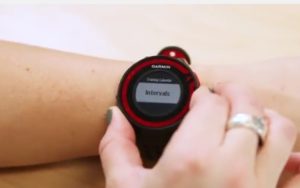 On a Fitbit watch, the heart rate sensor is an optical sensor that monitors blood flow through the wrist as a way of detecting heart beats. The problem is that the wrist has less tissue, more bones, and more tendons than other parts of the body so there isn’t real good blood flow there. Consequently, the accuracy of heart beat readings read optically can be suspect, particularly for those who work out hard enough to get a heart rate above 160 beats per minute. Then the blood is passing the sensor pretty fast and there tends to be a lot of body movement as well because you’re exercising hard. And it becomes really difficult to get an accurate reading.
On a Fitbit watch, the heart rate sensor is an optical sensor that monitors blood flow through the wrist as a way of detecting heart beats. The problem is that the wrist has less tissue, more bones, and more tendons than other parts of the body so there isn’t real good blood flow there. Consequently, the accuracy of heart beat readings read optically can be suspect, particularly for those who work out hard enough to get a heart rate above 160 beats per minute. Then the blood is passing the sensor pretty fast and there tends to be a lot of body movement as well because you’re exercising hard. And it becomes really difficult to get an accurate reading.
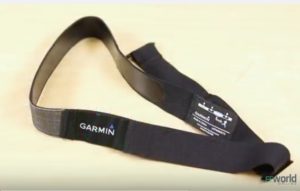
But the Garmin Forerunner doesn’t have that problem because it uses a different kind of heart beat monitor. The heart beat monitor is separate from the watch. It takes the form of a sensor on a strap that goes around the chest. Unlike in the Fitbit, the sensor doesn’t monitor blood flow. Like an EKG machine, it uses the fact that the heart generates an electrical signal as it beats. And this EKG activity can be detected through the skin.
However, there is a big difference between the functions of a conventional EKG machine and the sensor on the Garmin chest strap. When doctors look at an EKG display, they are keenly interested in the shape of the heartbeat. So EKG electronics contains super-sensitive instrumentation amplifiers and filters to let them record the shape of the beat accurately. But the heart beat monitor that works with the Garmin watch merely needs to count the beats. It doesn’t care about their shape. So it can be much simpler.
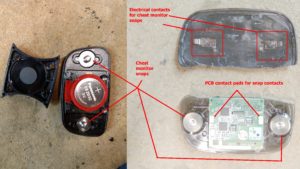
It is interesting to see the way the chest strap incorporates electrodes for heart beat monitoring. For conventional EKG tests, there are generally three contact points on the patient’s skin. The Garmin chest monitor, too, contains electrodes, but they are disguised. They take the form of the two snaps that attach the monitor to the strap. It looks like the snaps are there so you can remove the monitor to change the battery or to clean the strap. In reality, the snaps are also the electrodes.
This dual-use of the snaps explains why the strap must be worn next to your skin: so electrodes can make contact. When we pulled the monitor apart, we found small contacts that touched the snaps and bridged them to the inputs of a TI microcontroller. That connection is interesting because conventional EKG electronics usually contains a special chip that serves as a front-end to the EKG measurement. This chip usually contains an instrumentation amplifier and specialized circuits for managing the heart rate data.
In contrast, the Garmin chest monitor circuit contains none of that. The electrodes seem to just feed straight into the TI microcontroller without much other filtering or signal processing. We did find a few general-purpose transistors on the monitor board, some of which might be there to boost the heart rate signal, which can be on the order of tens of microvolts.
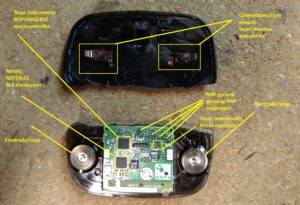
The low-level nature of the electrode signals might help explain the presence of what seem to be Zener diodes on the heart rate monitor board. We suspect they might be there in case a voltage gets applied to the two electrodes that is significantly higher than tens of microvolts. The zeners could conceivably act to limit the input voltage so it doesn’t somehow destroy the circuitry on the heart monitor board that’s set up to just work with microvolt-level signals.
Once the heart rate monitor detects a heart rate, it sends that information to the watch via Bluetooth. The chest monitor contains a widely-used Bluetooth chip from Nordic Semiconductor for that purpose. We also found a linear regulator made by Texas Instruments. There’s also a quarter-inch-long mystery device containing four terminals whose markings didn’t come back to anything on any of our Google searches.
Inside the watch
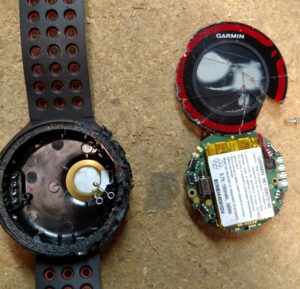
The watch itself uses an LCD which attaches to the circuit board with a flex connector. There are three eight-pin chips near the display connector which we surmise are display driver chips, though we can’t be sure because their markings aren’t definitive.
Next to the display connector is the Nordic BLE chip that communicates with the heart monitor and with a smart phone for uploading performance data to the cloud. Several components reside inside a metal shield. Closest to the display drivers is a low-power microcontroller from Texas Instruments. We might surmise that this processor is handling the display and other housekeeping chores on the watch.
The more complicated tasks, say, managing the GPS data, seem to be handled by a 120 MHz ARM Cortex M4 device from NXP that sits above the TI chip. Between the two processors are four Pericom four-bit level shifters that provide 16 bits of level shifting.
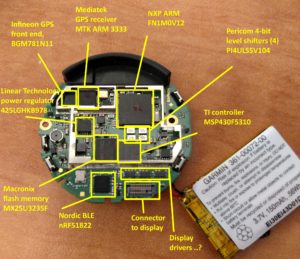
The presence of the level shifters is interesting. A level shifter connects one digital circuit that uses one logic level to another digital circuit that uses another logic level. But in this case, their presence is a bit of a mystery. They sit between the two processors which leads to the possibility that they are manipulating signals passing between the two. But it is not clear why: Both the TI processor and the NXP device are CMOS parts, so they both use CMOS logic levels. And they both work from the same power supply — the coin cell in the watch. So the reason for 16-bits-worth of level shifting isn’t readily apparent.
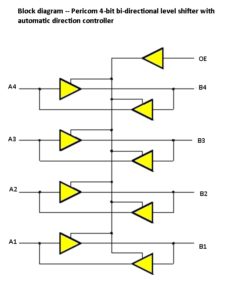
Besides the processors, there is a flash memory chip from Macronix that is a 32-megabit serial device. Near it resides a chip from Linear Technology that both manages the charging of the lithium-ion battery and regulates the overall use of power on the board. The location of the power manager IC is interesting: Designers chose to enclose it in the same metal shield that contains the processors and memory. But there’s no obvious need to put this chip inside a metal shield, so its presence there is noteworthy.
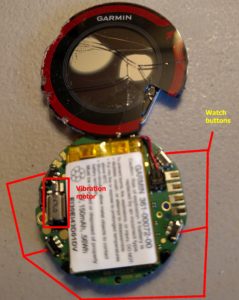
Additionally, a separate section of the board has its own separate metal shield. That section houses the GPS circuits. There are two main chips and a crystal oscillator in that section, plus a small chip we could identify. The big chip is a GPS receiver from Mediatek, a company in Taiwan that mostly makes chips for cell phones. Next to it is a GPS front-end chip from Infineon. The front-end chip does some filtering of the incoming GPS signal and amplifies it before it gets to the GPS receiver.
The reverse side of the watch PCB is less interesting. The 150 mA-h lithium-ion battery attaches to this side of the board. The only other major component is the vibration motor. It rotates an eccentric mass to provide a sort of buzzing for an alarm or haptic feedback.
All in all, Garmin’s watch is an example of what many IoT devices are likely to look like inside the package.
References
MSP430F5310 TI controller
Hello I have a Garmin forerunner 225 the GPS it does not work there is a solution Please
I have been searching about the garmin gps support phone number and finally, when I read this article I get to know the correct information about it and I found this information is relevant
You have an ample amount of knowledge and that describes it very clearly and I thank you for giving me this type of knowledge and it helps me a lot.
Where can I find the teardown instructions for the Forerunner 225 so I can replace the battery…? How do you access the battery…?
can anyone tell the electrical components of a chest trap heart monitor ?
what is the coil used inside the watch
Where would i be able to discover the teardown directions for the Forerunner 225 so I can supplant the battery… ? How would you access the battery… ?